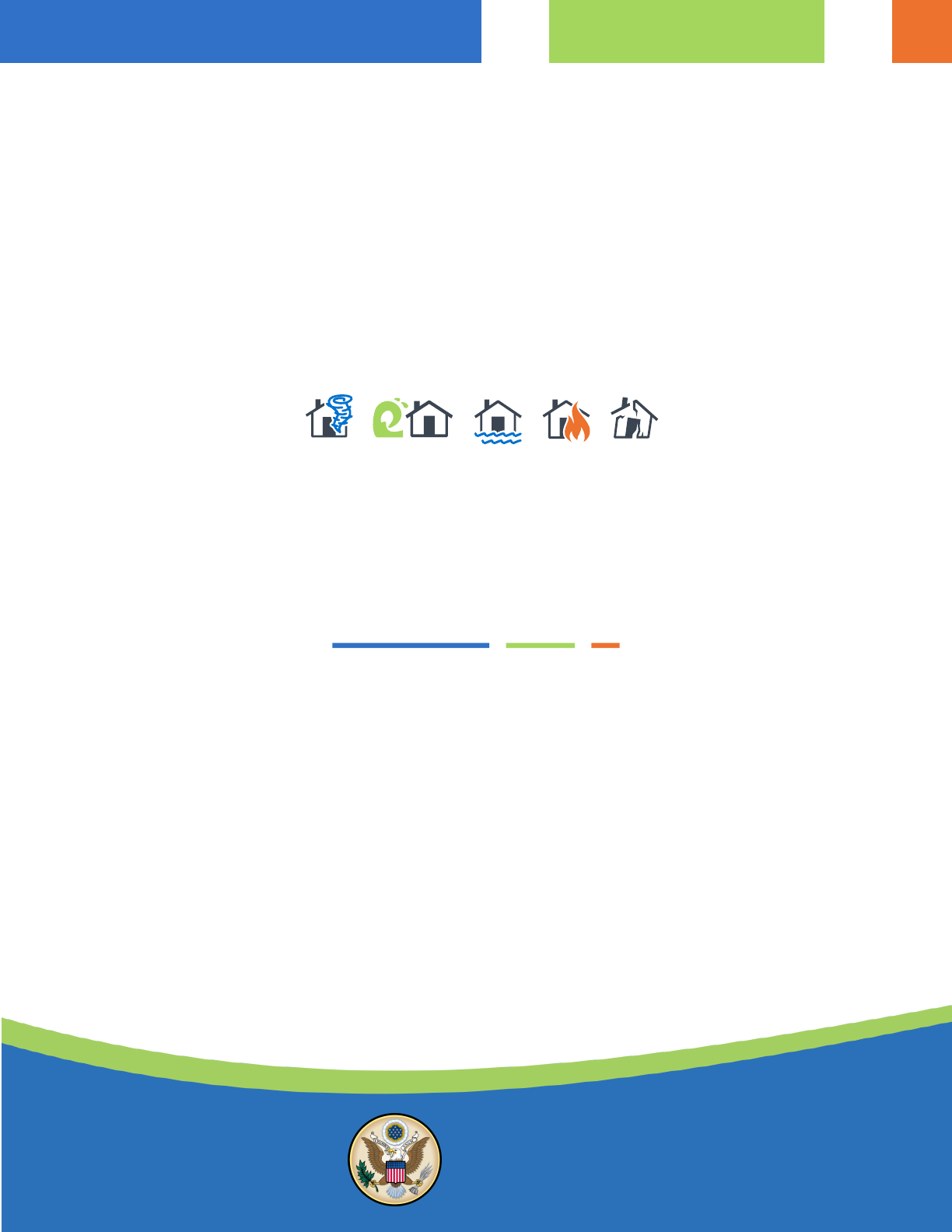
POST-DISASTER
CLAIMS GUIDE
Illinois Department of Insurance
122 S. Michigan Ave, 19th Floor
Chicago, IL 60603
(312) 814-2420
320 W. Washington St.
Springfield, IL 62767
(217) 782-4515
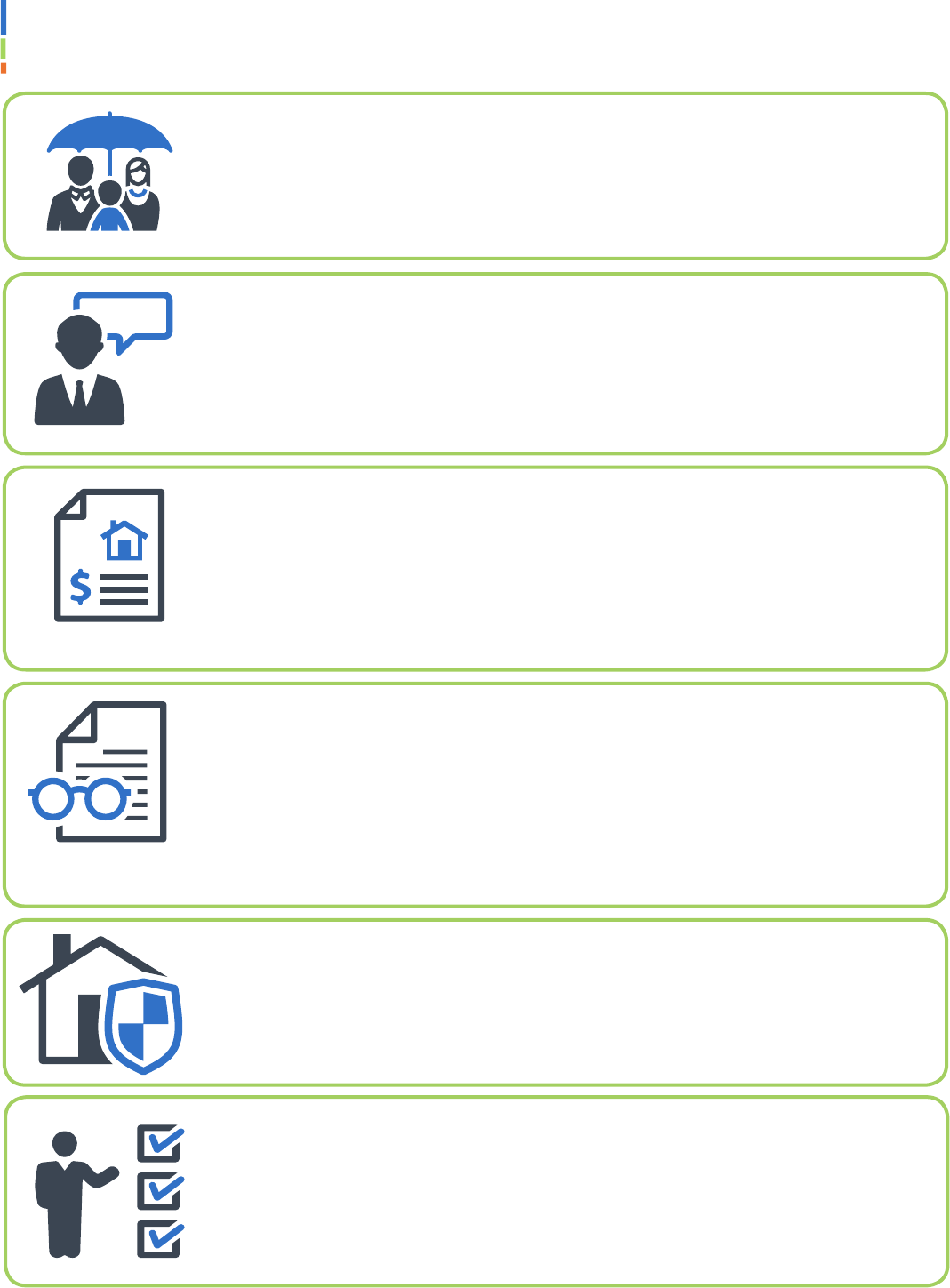
THERE'S BEEN A DISASTER - WHAT SHOULD I DO NOW?
SAFE AND SOUND
After a disaster hits, make sure you and your family are safe. Then secure your
belongings. Do what you can to secure your home and property to prevent more
damage or theft. For example, if windows are broken, board them up. If the roof has
a few holes, cover it with a tarp to prevent water damage.
REPORT A CLAIM
Once you’ve determined your home is damaged and needs to be repaired or rebuilt,
report or file a claim as soon as possible. The easiest way to report a claim is to call
your insurance company or agent. You may be able to report or file a claim online or
from your cell phone. If you have trouble finding a phone number, try searching for
your insurance company online.
ESTIMATE DAMAGE
An insurance adjuster will figure out how much damage was done to your home
and property. The adjuster will ask you for a home inventory (a list of your personal
property) if your personal belongings were damaged or destroyed. The adjuster will
visit your home to inspect and estimate the damage done. In this section, you can
learn about the different types of adjusters who may work on your claim and what
you should do to prepare to meet the adjuster.
DETERMINE COVERAGE
Once the adjuster has figured out how much it will cost to rebuild, repair or replace
your home or property, the adjuster will review your policy to calculate how much the
insurance company will pay. If you’ve never filed a claim before, this process can
seem overwhelming. But you can read this section to learn how claim payments are
calculated and how your coverage will impact what your insurance company pays.
You can learn the meaning of some of the words insurance companies use.
REBUILD, REPAIR AND REPLACE
Your recovery from a disaster is not complete until you're living back in your home.
During the recovery phase, you’ll be replacing personal items (if damaged), choosing
building materials and working with contractors. Read this section to find tips about
working with contractors and how to avoid becoming a victim of fraud.
PREPARE
It may sound strange, but the recovery process is the best time to start preparing
for the next disaster or claim. Create a home inventory list as you’re replacing your
belongings. Also as you’re rebuilding, consider using building materials that will resist
damage – so if there’s another disaster, your home may have less damage. For
example, you could use impact-resistant shingles or impact-resistant siding.
Learn more in the sections described below.
1
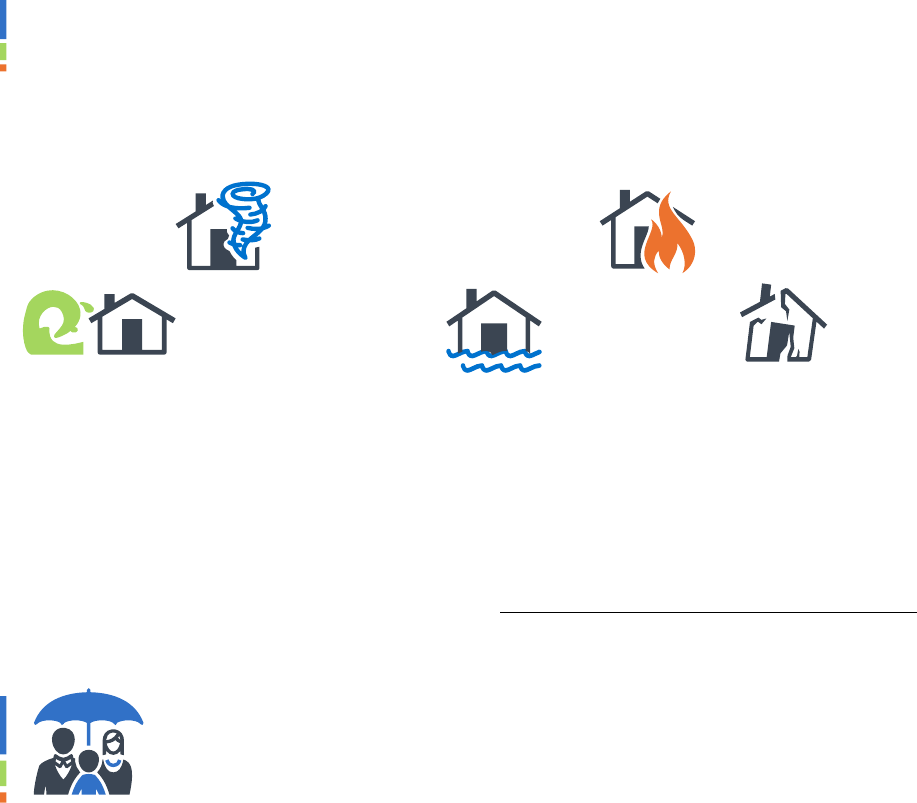
PROPERTY INSURANCE CLAIMS GUIDE
Disasters happen everywhere and can happen at any time. Any of the following can
cause a significant amount of damage to homes and personal property:
This might be the first time you've had an insurance claim – or maybe a claim this big.
This Guide will help you understand what to do after a natural disaster damages your home. It also gives you
helpful tools and tips to navigate the insurance claims process, whether this is your first insurance claim or
not.
This Guide provides general information to help you in any type of disaster. But remember, most policies
won't cover damage from floods or earthquakes unless you bought that coverage separately.
Your state insurance department will help you and answer any questions – free of charge.
SAFE AND SOUND
A disaster has hit my area and my home
has been damaged. I’ve made sure my
family is safe. What should I do next?
Make sure there are no safety issues like downed
electrical lines or broken gas lines. If there are safety
issues, leave your home and wait for or listen to your
local authorities to learn when you can return.
When inspecting your home, avoid broken glass and
sharp objects or remove them. Watch out for things
that could cause you to trip or fall.
Take photos or videos of the damaged areas and
personal property. You also can jot down notes
about any significant damage you see.
My family and I were evacuated from our
home. When can we go home?
Wait to return to your home until your state or local
authorities tell you it’s safe. The authorities won’t let
you return to your home if there are hazards like
downed power lines or broken gas lines. This is for
your safety.
There's a lot of damage to my home. What
should I do about the damage?
Try to prevent further damage by making essential
repairs, like covering roofs, or windows with
plywood, tarp, canvas, or other waterproof
materials.
IMPORTANT: KEEP ALL RECEIPTS FOR
EMERGENCY REPAIRS TO GIVE TO YOUR
INSURANCE COMPANY. Because you have to
prevent more damage, you may want to hire a
contractor to make any emergency repairs.
Don’t make permanent repairs before talking with
your insurance agent or insurance company. Your
company may not pay for repairs it didn't authorize.
If you’re contacted by any contractors, review the
section on Avoiding Insurance Fraud to avoid being
taken advantage of.
TORNADOES
WILDFIRES
HURRICANES FLOODS
EARTHQUAKE
2

ADDITIONAL LIVING EXPENSE ALE
Most homeowners policies also will pay the additional expenses you have if you can’t stay in your home
because of damage from a covered disaster. For example, if you've to move into a hotel or apartment while
your home is repaired or rebuilt, the insurance company will pay your costs for temporary housing.
Just don’t expect the insurance company to pay for your stay at a 5-star spa and resort or to eat out every
night at the most expensive restaurant in town.
ALE is limited; see below for more information.
Do your best to secure your home and personal
belongings.
Gather important papers, including insurance
policies and a list of all damaged or destroyed
personal property (a home inventory list), if you have
one. Take those with you if you can’t stay in your
home.
If you can’t stay in your home, save any hotel
receipts. Your insurance company will need the
receipts to repay you.
Contact your doctor’s office, pharmacy, or health
plan if your prescription medicines were lost or if
you lost your glasses, contacts, hearing aids, walker,
wheelchair, or other medical equipment in the
disaster.
Make sure you notify utilities and your mortgage
company and make arrangements for mail deliveries.
There's so much damage to my home, there’s no way I can stay. What should I do?
What types of living expenses does ALE
pay for?
The insurance company will not pay ALL of your
living expenses. ALE is to help pay those expenses
that are beyond your normal expenses because
you can’t live in your home. For example, ALE
coverage will pay hotel lodging, but it won’t make
your mortgage payment.
ALE typically covers hotel bills, reasonable
restaurant meals (if you’re staying in a hotel room
with no kitchen), and other living costs above and
beyond your normal housing expenses while you
can’t live in your home because of damage.
You need to be sure you keep ALL receipts for any
additional costs you have. The insurance company
will need the receipts to reimburse you.
Is there a limit to how long or how much I
can use for my additional living
expenses?
Keep in mind that ALE coverage is limited. Some
policies have a dollar limit; some also may have a
time limitation.
The good news – these limits are separate from
any coverage you have to rebuild or repair your
home. They're also separate from any coverage
you have to replace your belongings.
Ask
your insurance company or adjuster what
your policy covers and any time or dollar limits
that apply.
3
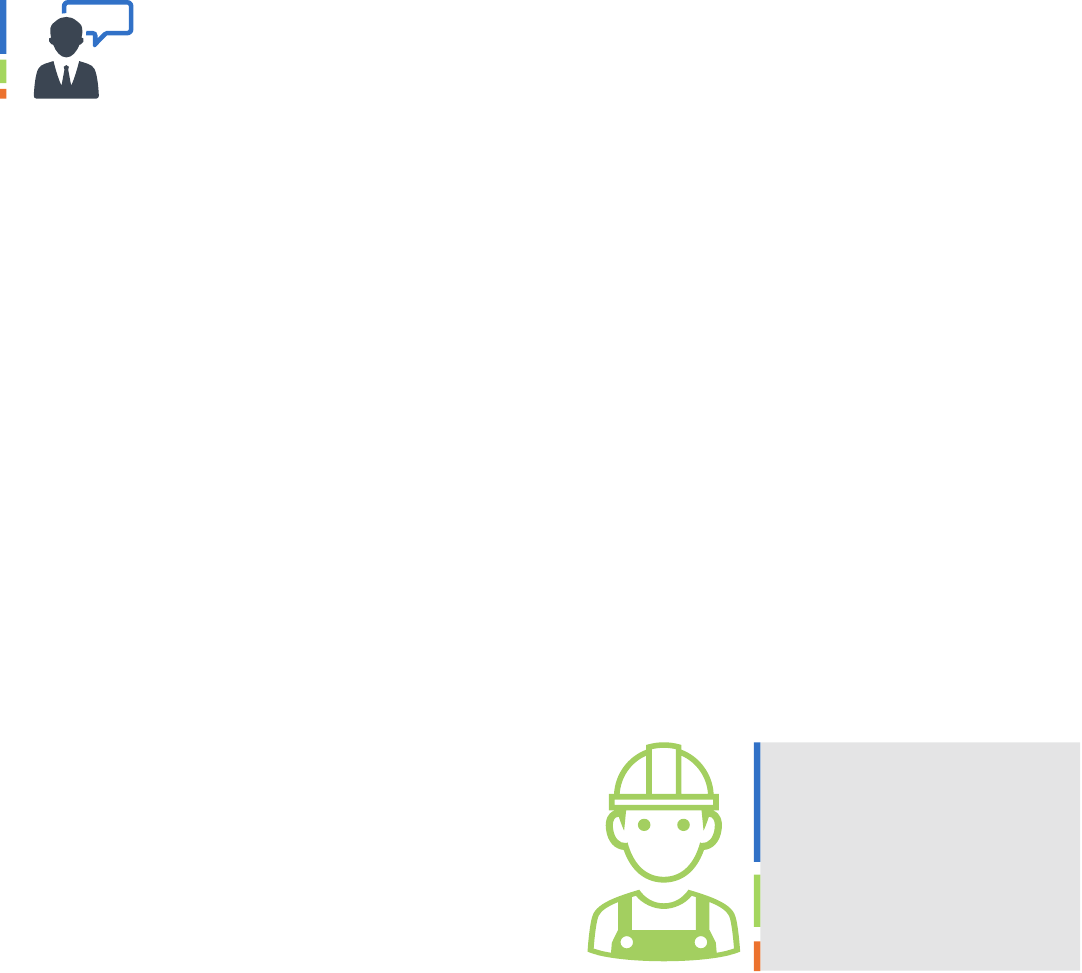
REPORTING AN INSURANCE CLAIM
When should I report damage to
my home or personal property?
Before reporting the property damage to your home,
find out what your deductible is. If the damage
is minor, for example, just a few shingles were
damaged, you might decide you’re better off paying
for the repairs out of pocket instead of filing an
insurance claim. But, remember you might not be
able to see all the damage. You may want to have a
contractor inspect your home.
If you believe the damage will cost more than
your deductible to repair, or there's a lot of damage,
you may want to file a claim. It’s important to notify
your insurance company as soon as you know
there’s damage and you decide to file a claim.
The easiest way to report damage is to call your
insurance company or agent directly.
What should I do if I don’t have my
company or agent’s phone number?
If you have cell service, use your cell phone to
search for phone numbers or the insurance
company’s website. There may be a phone number
to report a claim.
If you can access social media, you can search for
information from your insurance company or state
department of insurance about how to file a claim.
If you have limited or no cell service, look for mobile
claims centers in your area. Local news outlets and
social media usually announce their locations.
What do I need to know when I call to make
a claim?
It will help if you have your policy number. But if you
don’t, your insurance company or agent can find your
policy with your name, address, and phone number.
You’ll need to briefly explain what happened and
describe the type and extent of the property
damage.
If you aren’t staying in your home, be prepared
to give your insurance company and agent your
new contact information—a phone number and an
address.
Let your insurance company and agent know when
you call if you’ve taken photos and videos of the
damage and have cost estimates.
What is a contractor?
An individual you hire to manage
the repair of your home. The
contractor is responsible
for supplying the necessary
equipment, material, labor and
services to complete repairs.
4
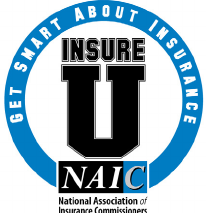
What do I need to ask when I file a claim?
You should ask:
• For the name and phone number for every
person you talk to.
• For your claim or reference number.
• How long you have to file a claim.
• If you need estimates to make repairs or
rebuild before you can file a claim.
• For a general idea of what your policy will
cover.
• If your insurance policy covers hotel costs. For
how much? For how long?
• For information about your deductible. Are
there separate deductibles for hail, hurricane,
or wind damage? What are those?
• If there are any special processes or
procedures you need to know about.
• When you can expect an adjuster to call.
• What other information the company will need
to process the claim.
What other information or paperwork could
the insurance company or agent ask for
during the claims process?
A list of all damaged or destroyed personal property
(a home inventory list) and receipts, if you have them,
showing when you bought the damaged or destroyed
items.
A list of damage to the home and other structures, like
a garage, tool shed, or in-ground swimming pool. You’ll
need this list when you meet with the adjuster.
What if I don’t have a completed home
inventory list?
Don’t worry; the adjuster will give you some time to
make a list. Ask the adjuster how much time you
have to submit this inventory list.
Work from memory if your property was destroyed
and you have no records.
Review photos, for example on your cell phone or
from family or friends, taken inside your home. That
may help you make the list.
Search online shopping websites or online
retailers to help estimate costs.
The National Association of Insurance
Commissioners (NAIC) has a printable inventory
listing that may help you as you’re making your list.
https://www.insureuonline.org/home_inventory_
checklist.pdf
5
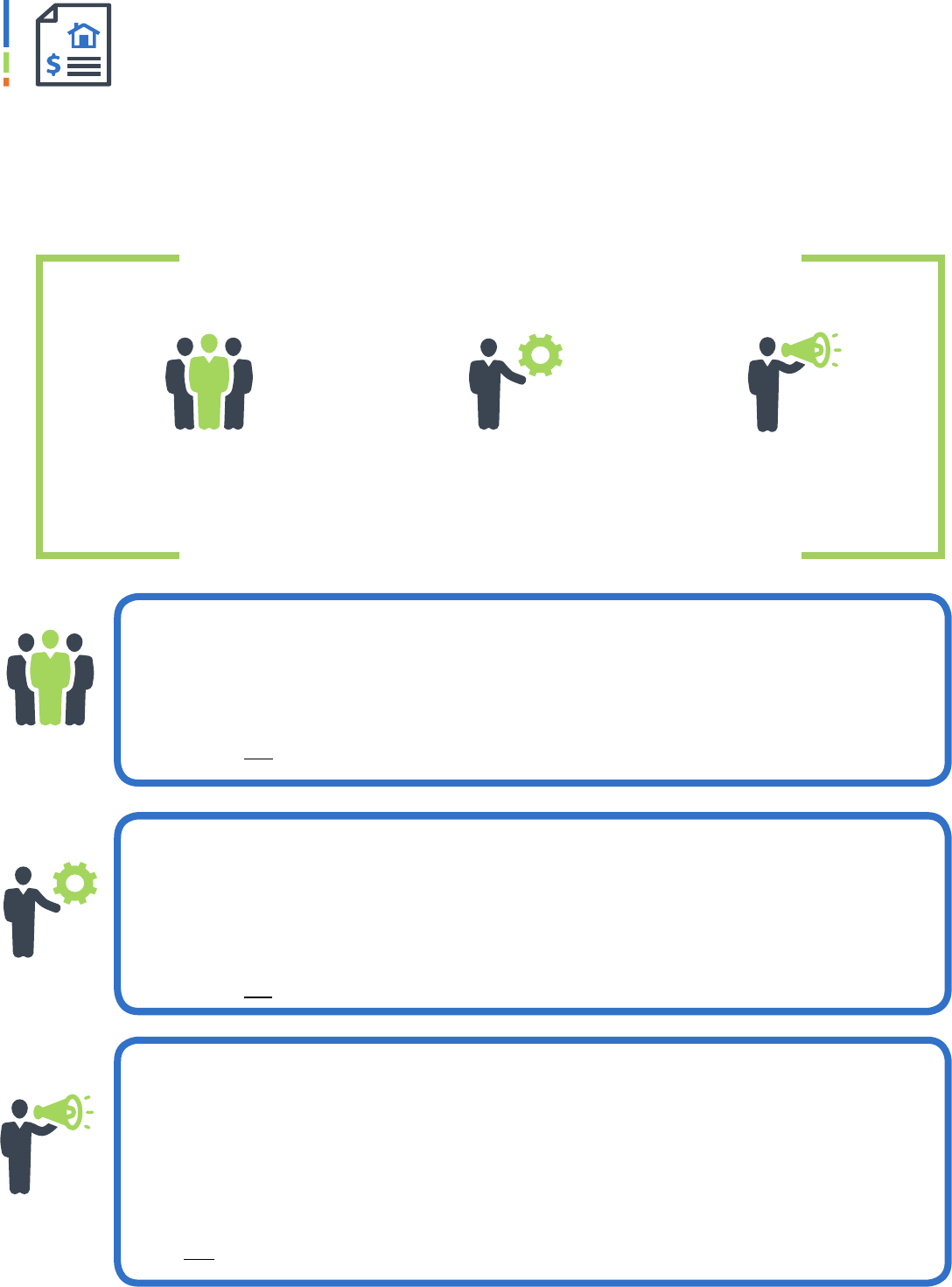
What is a company adjuster?
• A company adjuster works only for that insurance company.
• The insurance company hires and pays a company adjuster. This adjuster will settle the
claim based on the insurance coverage you have and the amount of damage to your
home and property.
• You do
not
pay a company adjuster.
What is an independent adjuster?
• An independent adjuster works for several different insurance companies. An
insurance company uses independent adjusters when it doesn’t have its own adjusters
on staff or when it needs more adjusters than it has available; this often happens in a
large disaster.
• An independent adjuster does the same work as a company adjuster (see above).
• You do not pay an independent adjuster.
What is a public adjuster?
• A public adjuster is a professional you can hire to handle your insurance claim.
• Public adjusters have no ties to the insurance company.
• They estimate the damage to your home and property, review your insurance
coverage, and negotiate a settlement of the insurance claim for you.
• Many states require public adjusters to be licensed. Some states prohibit public
adjusters from negotiating insurance claims for you. In those states, only a licensed
attorney can represent you.
• You have to pay a public adjuster.
ESTIMATING THE DAMAGE
What is an adjuster and what does an adjuster do?
An adjuster is a person who determines the amount of damage to your home and property - what can be
repaired or replaced, and at what cost. An adjuster reviews your insurance policy to determine if the
damage is covered and if there are any dollar limits or deductibles that apply. They also should explain your
policy’s coverage for the claim.
ARE THERE DIFFERENT TYPES OF ADJUSTERS?
COMPANY INDEPENDENT PUBLIC
Remember in larger weather events or disasters, not all adjusters will live or work in your
state. Some adjusters may be sent from other states to help when there's a large number of
claims.
6

WORKING WITH THE INSURANCE ADJUSTER
How long after I file a claim will an adjuster come to inspect my home?
It depends – every disaster can be different. Ask your insurance company when you file the claim.
If you don’t hear from an adjuster in a reasonable amount of time, contact your agent or the company. A
reasonable amount of time could be 3 to 5 days for a minor claim. But, it may take longer for the adjuster to
reach you following a large disaster in your area. Be sure they know how to contact you.
What should I do to prepare to meet with the adjuster?
• Make a list of all damaged or destroyed
personal property. Make a list of damage to
the home and other structures, like a garage,
tool shed, or in-ground swimming pool. Work
from memory or from photos if you have no
records of your destroyed property.
• Gather any photos or videos of your home
and property before they were damaged or
destroyed.
• Include receipts from when you bought the
damaged or destroyed items, if you have
them. Search online shopping sites or online
retailers to help estimate costs.
• If you have time before the adjuster inspects
your home, try to get written bids from
contractors. You aren’t required to have
bids, but it can help. The bids should detail
the materials to be used, prices of those
materials, and labor on a line-by-line basis.
• Take notes when you meet with the adjuster.
Get the adjuster’s name and contact
information and ask when you
can expect to hear back. You can write this
information down in the Claims
Communication Section in the back of this
resource.
What will happen when the insurance adjuster comes to my home?
• You should be there when the adjuster
comes to your home. You can show the
adjuster where you believe there has been
structural damage and give the lists you’ve
prepared of property or structural damage,
photos or videos you’ve taken, and bids
from contractors.
• The adjuster will inspect your home and take
photographs and measurements. While the
adjuster is there, they may even do some
calculations of the damage and cost to
repair.
• Before the adjuster leaves, make sure you
have their contact information. Ask the
adjuster what the next steps will be and to
estimate when you'll hear back from them.
• Ask the adjuster if there's any other
information you should provide. After the
adjuster leaves, you may need to gather
more information or start a personal
property inventory list.
If I hire a public adjuster, will the insurance company still send its own adjuster?
The insurance company doesn’t have to accept your public adjuster's estimates.
The insurance company will typically send either a company adjuster or an independent adjuster to assess
and estimate damage to your home or property.
7

How is a public adjuster paid?
• If you hire a public adjuster, it’s your
responsibility to pay their fee.
• Depending on the laws of your state, public
adjusters can charge a flat fee or a fee that’s
based on a percentage of the settlement you
get from your insurer.
• In some states, the maximum a public
adjuster can charge is set by law. The
maximum also may vary depending on
whether a widespread catastrophe caused
your loss.
• A public adjuster should give you a contract.
The contract should explain what services
the adjuster will provide and how much you
will pay.
• If you hire a public adjuster after your insurer
has made an initial offer, ask about the fee.
The contract should say if the fee you'll pay
will be based on the total the insurance
company pays or on the amount the public
adjuster negotiates for you.
• You should ask your public adjuster to
routinely provide you updates on the status
of your claim.
DETERMINING COVERAGE
SETTLING A CLAIM
How do I get a settlement offer? Who gives me that?
The company adjuster or independent adjuster will calculate the amount of damage to your home and
property. They will review your policy and determine what deductibles may apply and if there are any limits
on what will be paid. Once they’ve made those calculations, they’ll contact you and your public adjuster or
lawyer (if you have one) and share their estimates and calculations with you. They also may contact your
contractor about their estimates and calculations.
Will I get a lump sum payment and when will I receive money?
The settlement process is not a single transaction. You’ll get a number of payments for different parts of your
claim to help you start the rebuilding and repairing process. You’ll likely receive a payment for your additional
living expenses mentioned above. Then you'll start to receive payments to replace your personal property,
followed by payments for the repairs and construction on your home.
Why did the insurance company make the check payable to me AND my mortgage
company?
If you have a mortgage on your home, your lender has an interest in making sure the home is rebuilt – or that
your loan is paid in full. Your mortgage lender required you to add them as an additional insured on your
homeowners policy. Because of this, the insurer is obligated to include them on the check it pays for major
repairs. You’ll need to work with your mortgage lender to get the claim money released for repairs. If you
have problems working with your mortgage lender, contact your state’s agency that regulates banks and
mortgage lenders or your state’s Attorney General’s Office for assistance. The federal government also has
a website where you can make a complaint against your bank or mortgage lender, if you aren’t getting the
help you need. That website is: https://www.usa.gov/complaints-lender. Your state department of
insurance also may have suggestions for you.
8

How long will it take for my insurance claim
to be settled?
Everyone wants the process to be done as fast as
possible so they can return to a normal life.
If there’s substantial damage involving your home and
property, an insurance claim is not going to be closed
with a single payment. There will be claims payments
for various parts of your claim as the rebuilding
process moves along. Most people find it takes at
least 18 to 24 months to repair/rebuild their home and
replace their possessions after a major disaster. Your
insurance claim will stay open until the insurer has
made all payments you’re entitled to under your policy.
You should feel free to contact your insurance
company or adjuster for a status on your claim at any
time during the claims process.
What if I’m not satisfied with the amount of
my insurance settlement?
• Your settlement won’t necessarily be the
same as your neighbor’s. Your coverages,
deductible, and policy limits may be different
even if the damage looks the same.
• If the insurance company denies any part of
the claim, ask for the denial in writing. Keep all
paperwork.
• If you don’t believe the offer is fair, call the
insurance company. Be prepared to explain
why you think the offer is unfair. If you’re not
satisfied with the response, contact your state
insurance department.
What if the insurance company doesn’t agree
with the public adjuster’s or my contractor’s
estimate of the damage?
Differences in construction estimates are common.
Ideally, you and the insurance company should reach
agreement on a “scope of loss”. This is a detailed list
of the quantities of construction materials, labor,
profit and overhead, building code compliance, and
every single item required to repair or rebuild your
home.
Once you’ve submitted all the information that your
insurance company needs, including written estimates
from contractors, the adjuster will calculate the total
cost.
If you disagree with the claim amount the adjuster
has calculated, there are different ways to settle that
disagreement without going to court. Two ways are
appraisal and arbitration.
Appraisal: If you can't agree with your insurance
company about how much it will cost to rebuild your
home and/or repair or replace your property, you can
use the appraisal process to resolve the differences.
This isn't the same as an appraisal you may have of
your home's value.
The appraisal process begins with two appraisers
comparing their estimates. The appraisal process
only determines costs, not if your policy covers these
costs. It isn't a court proceeding.
If you use the appraisal process, you'll have to pay
some of the costs. What you'll have to pay will
depend on your state's law.
If your policy has an appraisal clause, you must go
through the appraisal process before you can sue
your insurance company.
Arbitration: Arbitration is a legal process, but you
don't have to go to court. In an arbitration hearing, a
neutral third party (arbitrator) hears from both you
and your insurance company. Both parties agree to
accept the arbitrator's decision. Usually the decision
is binding so you can't go to court to appeal the
decision.
Some insurance policies require arbitration to settle
differences. Other policies will say how arbitration
will work if both you and your insurance company
agree to use it. If you use arbitration, you'll have to
split the cost with the insurance company. But,
some state laws may require you or your insurance
company to pay the full cost if you aren't successful.
What can I do if my claim was denied?
If you think the insurance company should have paid
your claim, you can use arbitration or file a lawsuit to
get the insurance company to reverse its decision.
But, before you do any of those, contact your state
insurance department for help.
Some states may have a mediation process that you
can use. Contact your state department of insurance
for more information.
9
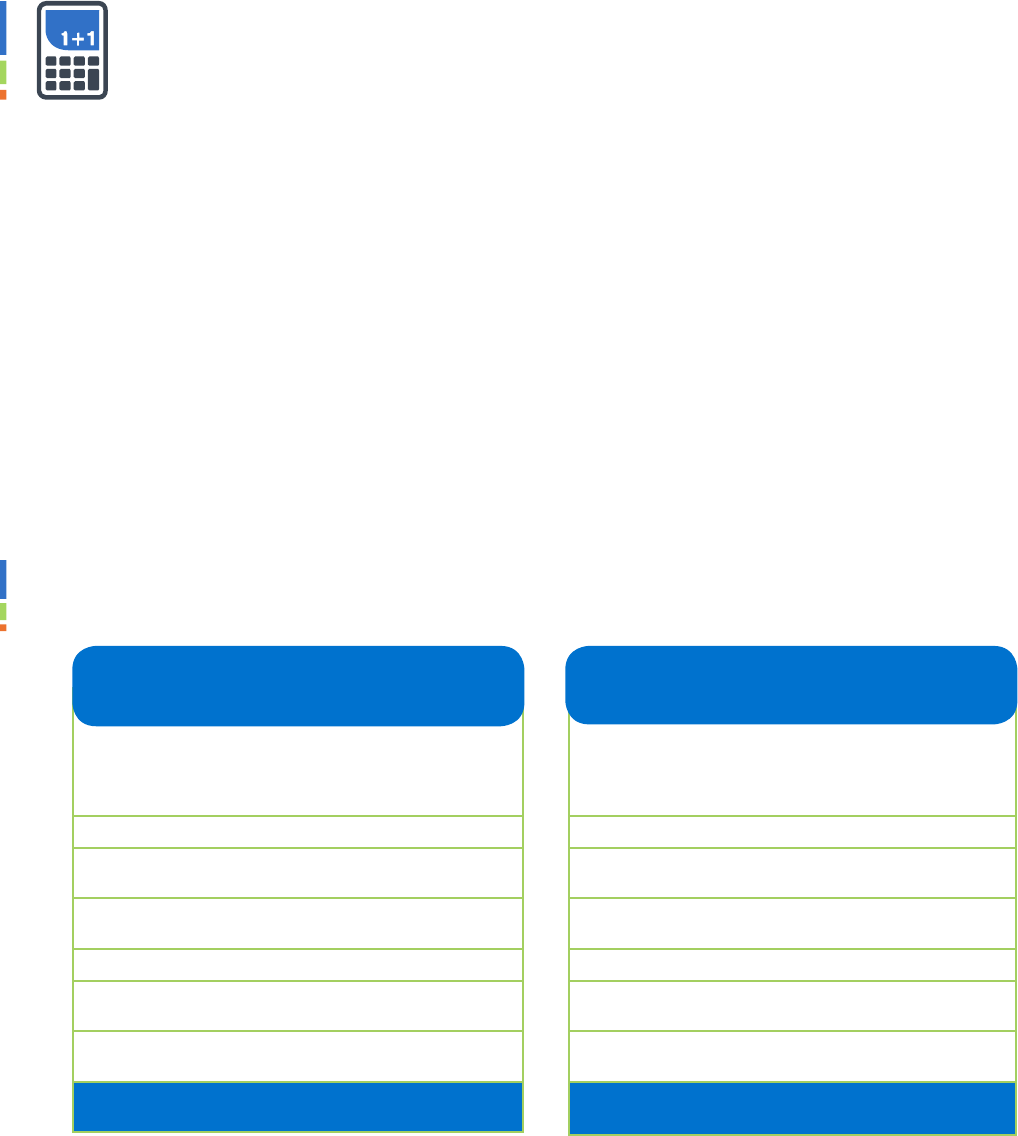
HOW IS A CLAIM PAYMENT AMOUNT CALCULATED?
A number of important insurance terms will help you understand how your insurance
claim will be paid. The following sections explain terms like deductible, depreciation,
Actual Cash Value, and Replacement Cost.
What is a deductible?
A deductible is the part (or amount
) of the claim you’re responsible for. Insurance companies will deduct this
amount from any claim settlements they pay to you or on your behalf. So if your insurance policy has a
$1,000 deductible, that means you've agreed to pay $1,000 out of your pocket for the damage to your home.
Are there different types of deductibles?
Yes. A deductible can be either a specific dollar amount or a percentage of the total amount of insurance.
There are special deductibles that apply to certain types of claims; some deductibles are applied to specific
parts of your home. Look at the declarations page or the front page of most homeowners insurance policies
to learn about your policy's deductible.
HOW ARE DEDUCTIBLES USED TO CALCULATE A CLAIM?
A disaster destroyed your home. Your home was
insured for $250K (structure only) and it will cost
$250K to rebuild it. You have a $500 deductible.
Damage and Cost to Rebuild: $250,000
Minus the Deductible:
- $500
Claim Settlement Amount: $249,500
A disaster destroyed your home. Your home was
insured for $250K (structure only) and it will cost
$250K to rebuild it. You have a 2% deductible.
Insured Value: $250,000
2% Deductible: $250,000 x 2% = $5,000
Damage and Cost to Rebuild: $250,000
Minus the Deductible:
- $5,000
Claim Settlement Amount: $245,000
FLAT DOLLAR DEDUCTIBLE
DEDUCTIBLE PER LOSS
PERCENTAGE DEDUCTIBLE
DEDUCTIBLE PER LOSS
Some insurance policies have a special deductible for losses caused by wind, hurricanes, or other types
of storms. The insurer applies this deductible when one of those types of disasters causes the
damage. If something else damages your home, then the “all peril” deductible would apply.
Some policies also may have a special deductible that applies to a specific part of your home, like your
roof. In these cases, the deductible could be either a flat dollar amount or a percentage.
10
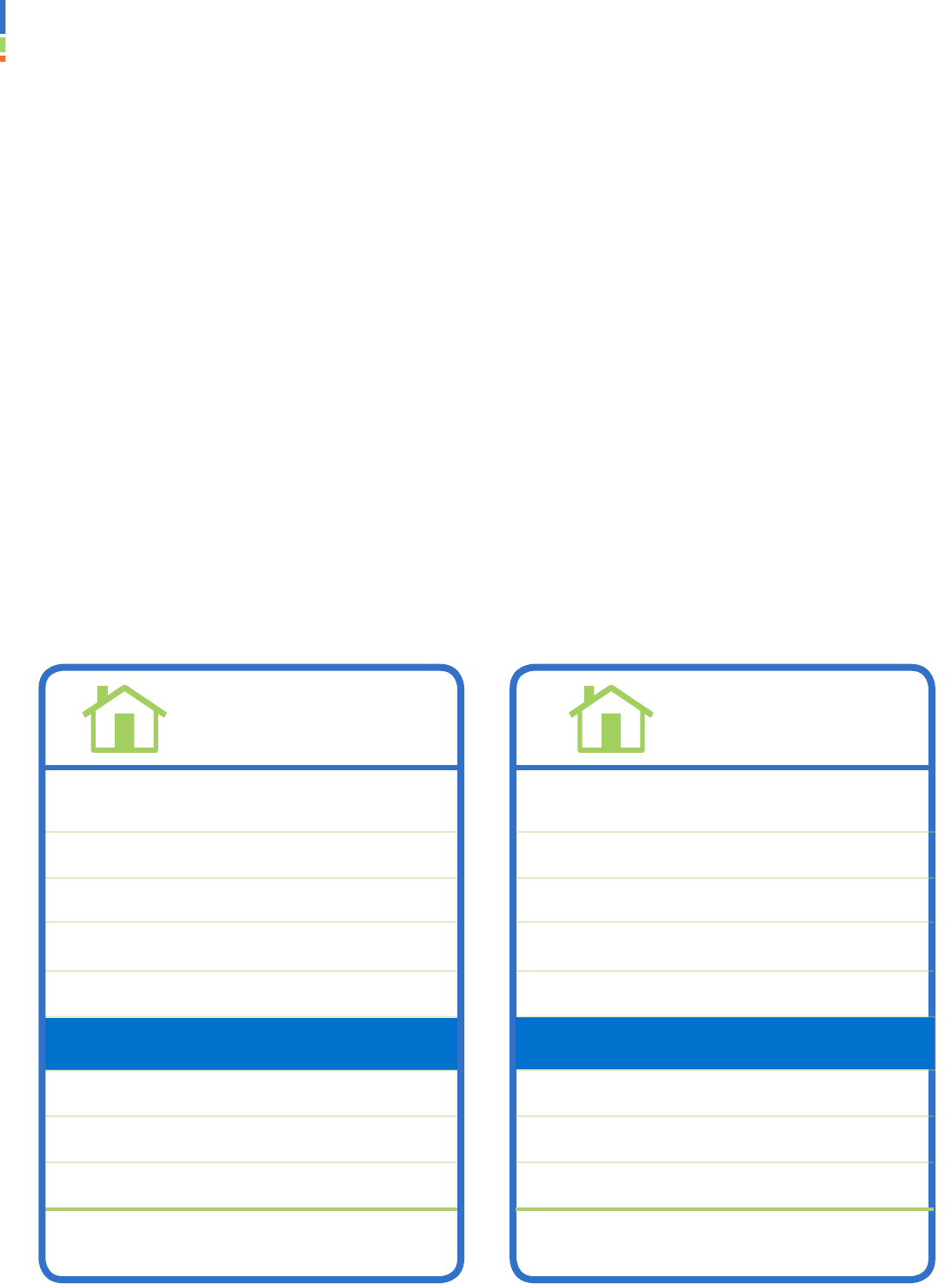
REPLACEMENT COST VERSUS ACTUAL CASH VALUE
If you have Replacement Cost Value (RCV)
coverage, your policy will pay the cost to
repair or replace your damaged property
without deducting for depreciation.
If you have Actual Cash Value (ACV)
coverage, your policy will pay the
depreciated cost to repair or replace your
damaged property.
Check the declarations page of your homeowners policy to see whether the policy provides
replacement cost coverage. If it doesn't specify replacement cost, then your policy likely only covers actual
cash value. If it specifies replacement cost, then you have replacement cost coverage.
Under an RCV or ACV policy, your dwelling coverage pays for damage to the structure and will pay only up to the
policy limit.
Even if you bought an RCV policy, there may be other limits on what the policy will pay for damage to certain
surfaces, such as roofs. In some cases, the policy may pay ACV on your roof, but RCV on the rest of your home
and property. If you have questions, call the adjuster or your insurer and ask what type of coverage you have.
Example:
The Smiths and the Johnsons are next door neighbors. Their homes are exactly the same size, built in the same
year, and have the exact same floorplan. One night, a terrible storm tears through their town, destroying the
Smith’s and the Johnson’s roofs. Both roofs have the same damage. The Smiths and the Johnsons have a $1,000
deductible, and both roofs will cost $15,000 to replace. The Smiths have a replacement cost policy, while the
Johnsons have an actual cash value policy.
JOHNSON’S
ACTUAL CASH VALUE
SMITH’S
REPLACEMENT COST VALUE
Insurance valuation method: ACV
Cost of Johnson’s roof ten years ago: $15,000
Policy deductible: $1,000
Cost to replace roof: $15,000
Depreciation schedule: $1,000/year
Insurance payment:
$15,000 cost of new roof
– $10,000 depreciation ($1000/yr x 10 years)
– $1,000 deductible
= $4,000 insurance payment
Insurance valuation method: RCV
Cost of Smith’s roof ten years ago: $15,000
Policy deductible: $1,000
Cost to replace roof: $15,000
Depreciation not applicable for RCV
Insurance payment:
$15,000 cost of new roof
– $0 depreciation (no depreciation with RCV)
– $1,000 deductible
= $14,000 insurance payment
1
1
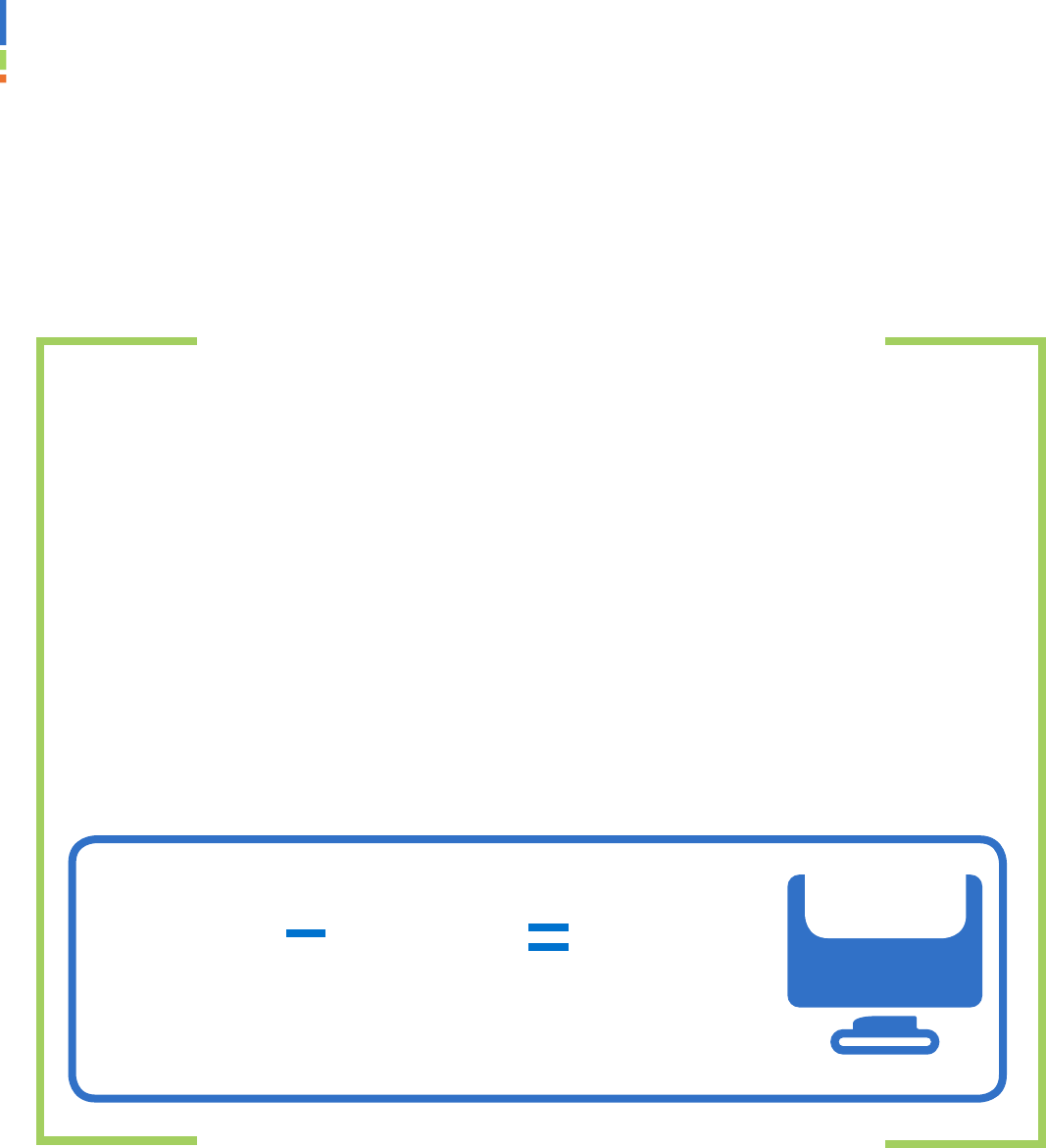
HOW DOES DEPRECIATION WORK?
IS ALL DEPRECIATION THE SAME?
No. Depreciation in an insurance claim is much different than depreciation on assets for taxes and is
different from an accountant's calculation of depreciation on property.
In an insurance claim, the deduction for depreciation may be significant, especially if the damaged property
was at or near the end of its useful life. For example, if a covered cause of loss destroys your 20 year old roof
and it must be replaced, a policy that pays RCV will cover the full cost to replace the roof. However, an ACV
policy may pay as little as 20% of the cost to replace the roof, since the useful life of a roof is usually about 25
years.
WHAT IS “DEPRECIATION” AND
HOW DOES THAT AFFECT MY CLAIM?
Everything covered under your homeowners policy is assigned a value. Your home, and
most of its contents and components, are likely to decline in value over time because of
age or wear and tear. This loss in value is known as depreciation.
Insurers usually calculate depreciation based on the condition of the property when it
was lost or damaged, what a new one would cost, and how long the item would
normally last.
For example, your two-year old laptop that was in good condition was destroyed in a
disaster. A similar new laptop would cost $750. Your laptop normally lasts four years,
so it had lost 50% of its value (25% a year). So, the value of your laptop at the time it
was destroyed was half of $750, or $375. Your insurance settlement would include
$375 to reimburse you for this laptop.
$750 $375
$375
Cost of new laptop
(Replacement cost value)
50% depreciation
(2 years x 25% per year)
Value of your laptop
(Actual cash value)
1
2

I have a replacement cost policy,
but my insurance company only
paid for part of the claim.
Can they do that?
When you have an RCV policy and turn in a
claim for a covered loss, the insurer at first
may pay only the ACV for the damage
to your home or personal property.
But, when you present evidence that the
damaged property has been repaired or
replaced, the insurer will pay the difference
(this is referred to as “recoverable
depreciation”) up to the replacement cost.
Recoverable depreciation is calculated
as the difference between an item's
replacement cost and ACV.
Is there a time limit on when I
can get paid for the recoverable
depreciation?
Yes, there’s usually a time limit. That time
limit can range from 6 months to up to
one year, depending on your state’s laws
and your policy.
In certain circumstances, like a very large-
scale disaster, insurance companies know
it will take longer to rebuild homes and
replace property. They'll give you more
time if you ask. Your state insurance
department may require the insurance
company to give you more time.
If you have questions about this time
frame, ask your adjuster. You also can
contact your state insurance department.
I was told I have to replace with “like kind and quality”. What does that mean?
Most insurance policies that are Replacement Cost cover repairs or replacements with property of
“like kind and quality”.
Your insurance policy isn’t intended to pay for expensive improvements or upgrades. For example, if
you had a 3-tab shingle roof before the loss, your insurance policy would cover the cost of another 3-
tab shingle roof, but not a more expensive slate roof. If you had ceramic bathroom sinks in your home,
your insurance policy won’t pay the extra cost to replace those with granite countertops.
What is “Functional Replacement”?
Another type of coverage becoming more common, particularly with older homes, is known as
“Functional Replacement Coverage” (FRC). FRC replaces the damaged property with a functional
replacement, which isn’t necessarily the same quality and craftsmanship as the original materials.
A simple example would be replacing plaster walls with drywall. Both provide solid walls and have the
same function, yet the cost varies greatly between the two. Another example would be a damaged
banister in a home. The repair could be made with wood carved in the same architectural style, but
using a less expensive wood – for instance, replacing an oak banister with a pine banister. Another
example would be replacing a tile roof with a shingle roof.
1
3

My adjuster mentioned that some
of my property has a special limit.
What is that?
A special limit caps how much money
you’ll be paid for certain types of
property. Don’t confuse this with the
contents or personal property limits.
A special limit will apply to specific
categories of property like jewelry, furs,
guns, antiques, collector items, and
coins.
My home and/or property were
destroyed and can’t be repaired.
Can I use the insurance settlement
to build or buy another home
somewhere else?
Check your insurance policy and talk with
your agent or company. You also can call
your state department of insurance.
You may not get the same settlement if you
don’t rebuild on the same location.
WHAT IS ORDINANCE AND LAW COVERAGE?
• In many instances, your local government may require your home to be repaired or rebuilt to meet
current local building codes. Unless you have Ordinance and Law coverage, a standard homeowners
policy doesn’t cover that added expense.
• Ordinance and Law coverage in your homeowners insurance policy covers part or all of the cost to
repair or rebuild your home to meet current local building codes. For example, electrical wiring,
plumbing, windows, and roofing materials are some things that may need to be updated.
• Standard homeowners policies don’t cover the added expense to meet current building codes
when you repair or replace your home. Look at the declarations page of your policy to see if you
have Ordinance and Law coverage.
1
4

THE THREE “R’S” OF RECOVERY
I’ve accepted the insurance company’s settlement and I’m ready to repair/rebuild. What do I
need to know?
• Use reputable contractors. Reputable contractors usually don’t ask for a large payment upfront.
• Contractors may be licensed or registered. The difference is important. A licensed contractor has
passed exams and met other requirements to show that he or she is competent. A registered
contractor has provided contact information to a government authority. You can learn more about
licensing and registration of contractors by calling your state Department of Insurance. They can
help you contact the state agency that licenses and regulates contractors.
• Ask your contractor to show you the building permits. Contractors most likely will need to apply and
pay for building permits before beginning work. And, don’t forget to check with your local officials
about any requirements for permits or inspections.
• Get an estimate from more than one contractor. An estimate from a contractor that's much lower
than any of the others doesn't mean it's the best deal. Make sure all the quotes include the same
things and check references.
• Contact your insurance company and adjuster any time you find damage that hasn’t already been
reported or inspected or if you learn something new about damage to your home or property.
What should I know about a contractor before hiring one?
Get the following information:
•
a copy of the contractor’s identification (the contractor’s name and the name of the business);
• a copy of the contractor’s business license (check the expiration date);
• a copy of the contractor’s proof of worker’s compensation insurance; and
• a copy of the contractor’s proof of liability insurance. A licensed insurance agent or company issues
this certificate. The proof of insurance should show the company’s name, phone number, and the
policy number. Call the insurance company to verify the coverage.
REBUILD
REPAIR
REPLACE
15

WHAT CAN I DO TO AVOID INSURANCE FRAUD?
After storms and other disasters, fraudsters and scam artists often arrive quickly. Watch for
contractors who offer to do your repairs with upgraded or free building materials. Here are a few tips to
help you avoid becoming a victim of a disaster fraudster or scam artist:
• If you’re working with contractors you don’t know, find out where they’re from. Many fraudsters will
travel from state to state.
• Before you sign any contracts or pay any money, ask for references.
• Never pay the full amount before the work is complete.
• Ask your local Better Business Bureau and state Attorney General’s Office about complaints.
• Check online for information about the contractor.
• Most importantly, report any suspected fraud to your insurance agent and your state’s department
of insurance as soon as possible.
Some states allow assignments of benefits (AOB) after a loss. This agreement transfers your rights under
your insurance policy and your claim to a third party, most often your contractor.
Be cautious if you’re asked to sign an AOB. Typically, there’s a promise from the contractor to handle all
matters with the insurance company for you, which may sound great. But you also may be giving up some,
most, or even all of your rights, including having a lawsuit filed without your approval or knowledge.
Take your time to review any AOB carefully. Talk to your claims adjuster or you can ask an attorney to
review and give you advice. You can also call your state department of insurance.
ASSIGNMENT OF BENEFITS
16
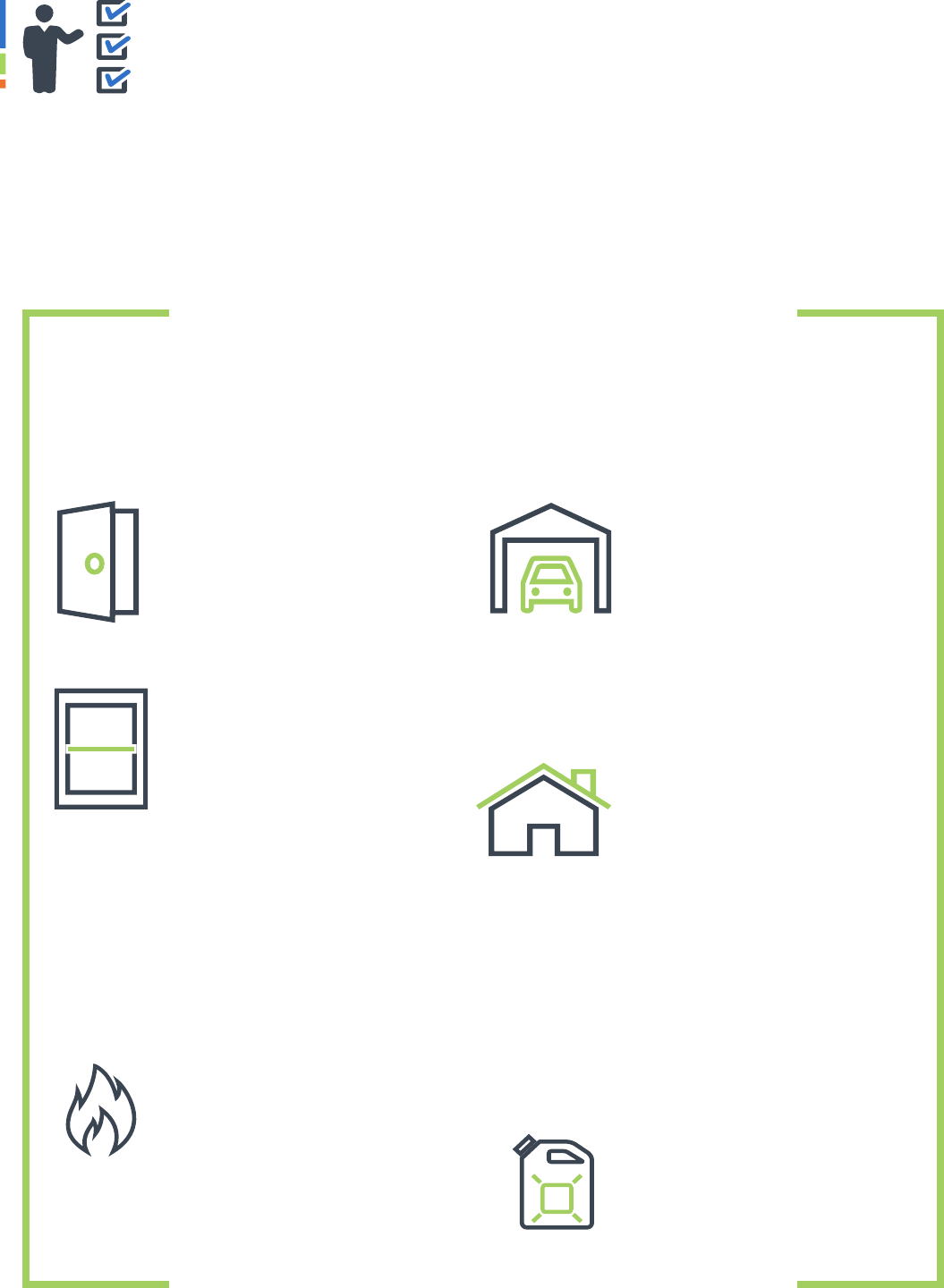
MOVING ON & LOOKING FORWARD
I’ve just gone through one disaster. What do I need to do to prepare for the next disaster?
There are two different parts of preparation – preparing your home and preparing yourself financially.
Preparing your home
While you're rebuilding, think about what you can do to minimize damage to your home during the next storm
or disaster. This is called mitigation.
WAYS YOU CAN LIMIT FUTURE DAMAGE:
You can make changes to your home to limit damage during a future tornado, wildfire,
hurricane, or high wind.
Brace your garage door. You can
buy bracing products that will
make your door stronger and more
wind resistant. If you’re expecting
bad weather and haven’t braced
your garage door, you can put
a vertical brace into the wall
framing and floor, much as you
would board up a window before a
hurricane.
Install wind-resistant roof
structures. Roofs are usually
installed with roofing nails. But
this type of roof can come off in
high winds. Using hurricane clips
to attach roofs creates a stronger
connection between the roof and
the house. Roofing clips come in a
range of protection; the one you
need depends on the weight of
your roof. The building codes in
hurricane-prone areas requires
roofing clips, but they’re a good
idea in tornado-prone areas too.
Secure entry doors.
Make sure
entry doors have a two-inch
deadbolt and three hinges with
screws long enough to secure the
door and frame to the wall. The
frame should be well anchored.
Install impact-resistant
windows. Local building codes in
some areas require this.
Leave the windows closed in a
storm. Opening the window
doesn’t equalize the pressure
between the inside and outside of
the house. Instead, it pressurizes
the inside of the house, like blowing
up a balloon until it pops. The air
pushes off the roof or a wall and the
house collapses.
Create a wildfire defense area.
Remove flammable materials from
around your home. Trim over
hanging branches. Remove dead
trees and bushes. Clean gutters
and clear them of leaves and pine
needles.
Install mesh screens over exterior
vents. This will prevent fire embers
from getting inside your home.
Store firewood and other
flammable materials away
from home, garage, or deck.
17

A number of great resources are available online can give you more ideas about ways you can reduce or
avoid damage to your home.
• Ready.gov (US Department of Homeland Security)
• FEMA Mitigation Resources (US Department of Homeland Security)
• Ready, Set Go! (Wildfire resiliency)
PREPARING YOURSELF FINANCIALLY
Once you've rebuilt or repaired your home, and you’re replacing damaged property, it’s time to prepare for
the future.
• You should make a list of all your stuff, called an inventory list. If you don’t want to write everything
down or type it into a spreadsheet, you can film a video to show your household items. As you film,
you can describe important items, including when you bought the item, its condition, and
how much you paid for it, if you know. There also are many mobile apps that will make it
easier to create an inventory list. The National Association of Insurance Commissioners
(NAIC) has a free app called the MyHOME Scr.APP.book that can be downloaded in
the Apple App Store or on Google Play.
• Make a copy of your inventory list and keep it with your insurance policy. You could put the copy
somewhere safe, such as a bank safety deposit box. You also could store a copy online.
• Put your insurance company name, policy number, and company contact information somewhere
you could find it in a disaster.
• Review your policy with your insurance agent each year to see if your needs have changed.
18

CLAIM INFORMATION
Name of Insurance Company:
Claim Number:
Phone Number:
INSURANCE ADJUSTER INFORMATION
Adjuster Name:
Adjuster Company:
Phone Number:
Adjuster License Number:
Website:
CONTRACTORS
Name of Company:
Representative:
Phone Number:
License Number:
I checked:
With my Insurance
Company
They have liability
Insurance
With the Better Business
Bureau
Online Search
Name of Company:
Representative:
Phone Number:
License Number:
I checked:
19
They have liability
Insurance
With my Ins
urance
Company
With the Better Business
B
ureau
Online Search

Who did I talk to:
Name of Company:
Date/Time:
What we talked about:
What is Next:
Who did I talk to:
Name of Company:
Date/Time:
What we talked about:
What is Next:
CLAIM COMMUNICATION LOG
20

Who did I talk to:
Name of Company:
Date/Time:
What we talked about:
What is Next:
Who did I talk to:
Name of Company:
Date/Time:
What we talked about:
What is Next:
CLAIM COMMUNICATION LOG
21

EMERGENCY REPAIR LOG
Repair:
Cost of Repair:
Date of Repair:
To help you keep track of any emergency repairs, here are some forms to help you.
Repair:
Cost of Repair:
Date of Repair:
Repair:
Cost of Repair:
Date of Repair:
Repair:
Cost of Repair:
Date of Repair:
22

Repair:
Cost of Repair:
Date of Repair:
Repair:
Cost of Repair:
Date of Repair:
Repair:
Cost of Repair:
Date of Repair:
Repair:
Cost of Repair:
Date of Repair:
23
EMERGENCY REPAIR LOG
To help you keep track of any emergency repairs, here are some forms to help you.
